US30 DB2: Comparing and Contrasting Different Chart Types
VerifiedAdded on 2022/10/19
|7
|953
|362
Homework Assignment
AI Summary
This assignment provides a comprehensive comparison of various chart types used in data visualization. It explores the purpose, data types, and best use cases for pie charts, donut charts, bar charts, column charts, line charts, area charts, and scatter charts. The document explains the specific applications of each chart type, including when they are most effective for representing different types of data and communicating insights. Additionally, it addresses different options for visualizing a single number and discusses the appropriate scenarios for using donut charts. The assignment also includes references to support the information presented. This assignment is useful for students to understand various aspects of data presentation through different charts.
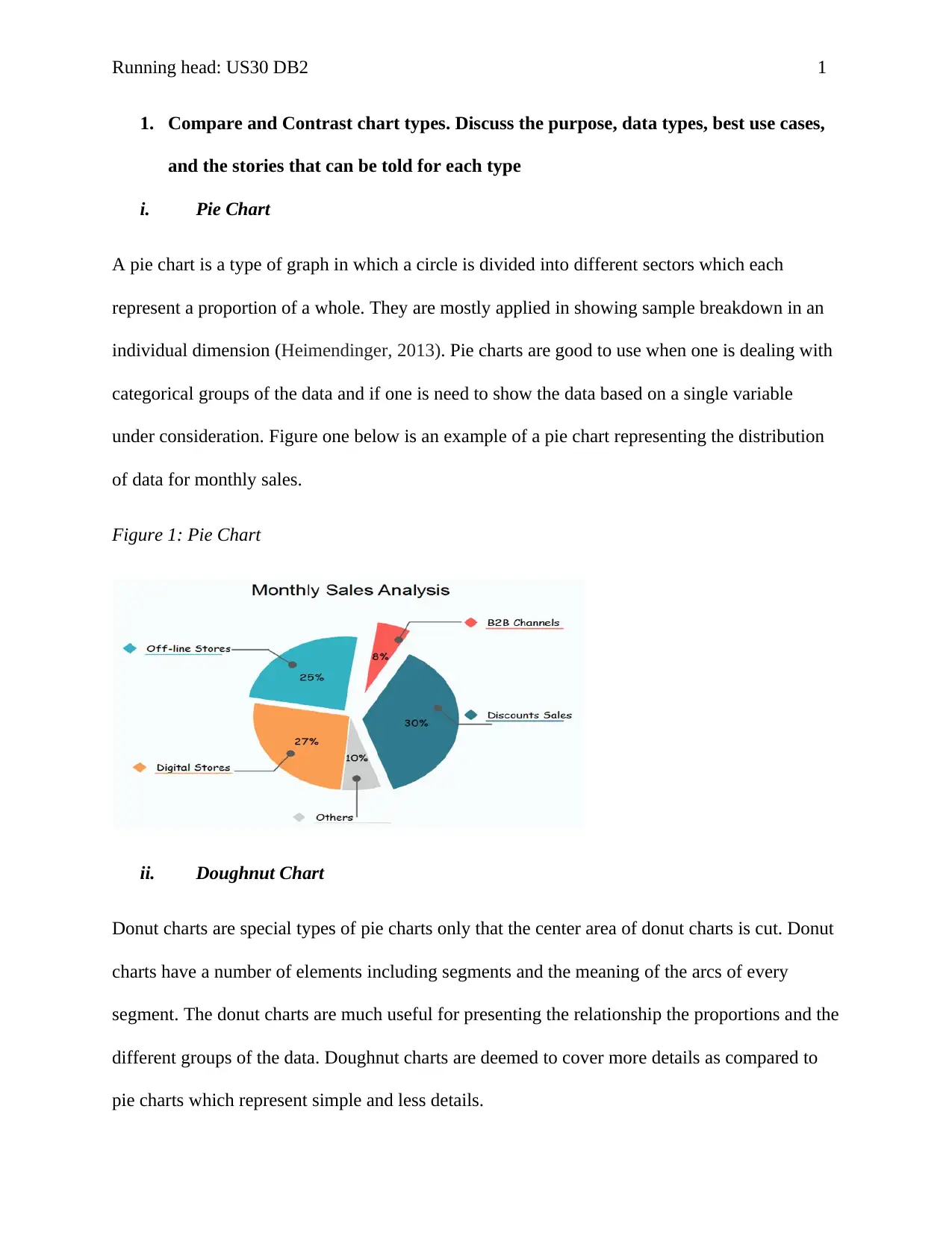
Running head: US30 DB2 1
1. Compare and Contrast chart types. Discuss the purpose, data types, best use cases,
and the stories that can be told for each type
i. Pie Chart
A pie chart is a type of graph in which a circle is divided into different sectors which each
represent a proportion of a whole. They are mostly applied in showing sample breakdown in an
individual dimension (Heimendinger, 2013). Pie charts are good to use when one is dealing with
categorical groups of the data and if one is need to show the data based on a single variable
under consideration. Figure one below is an example of a pie chart representing the distribution
of data for monthly sales.
Figure 1: Pie Chart
ii. Doughnut Chart
Donut charts are special types of pie charts only that the center area of donut charts is cut. Donut
charts have a number of elements including segments and the meaning of the arcs of every
segment. The donut charts are much useful for presenting the relationship the proportions and the
different groups of the data. Doughnut charts are deemed to cover more details as compared to
pie charts which represent simple and less details.
1. Compare and Contrast chart types. Discuss the purpose, data types, best use cases,
and the stories that can be told for each type
i. Pie Chart
A pie chart is a type of graph in which a circle is divided into different sectors which each
represent a proportion of a whole. They are mostly applied in showing sample breakdown in an
individual dimension (Heimendinger, 2013). Pie charts are good to use when one is dealing with
categorical groups of the data and if one is need to show the data based on a single variable
under consideration. Figure one below is an example of a pie chart representing the distribution
of data for monthly sales.
Figure 1: Pie Chart
ii. Doughnut Chart
Donut charts are special types of pie charts only that the center area of donut charts is cut. Donut
charts have a number of elements including segments and the meaning of the arcs of every
segment. The donut charts are much useful for presenting the relationship the proportions and the
different groups of the data. Doughnut charts are deemed to cover more details as compared to
pie charts which represent simple and less details.
Paraphrase This Document
Need a fresh take? Get an instant paraphrase of this document with our AI Paraphraser
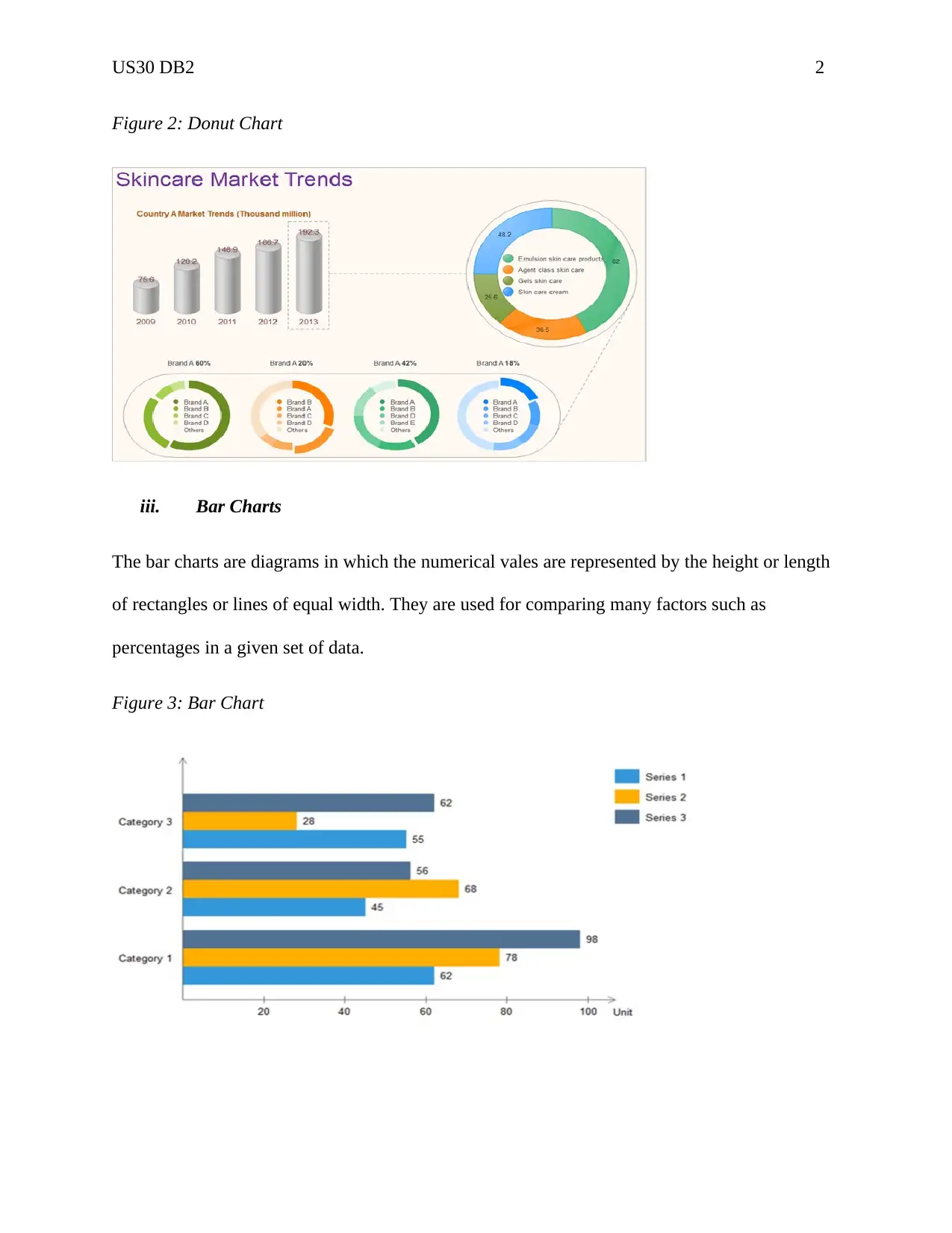
US30 DB2 2
Figure 2: Donut Chart
iii. Bar Charts
The bar charts are diagrams in which the numerical vales are represented by the height or length
of rectangles or lines of equal width. They are used for comparing many factors such as
percentages in a given set of data.
Figure 3: Bar Chart
Figure 2: Donut Chart
iii. Bar Charts
The bar charts are diagrams in which the numerical vales are represented by the height or length
of rectangles or lines of equal width. They are used for comparing many factors such as
percentages in a given set of data.
Figure 3: Bar Chart
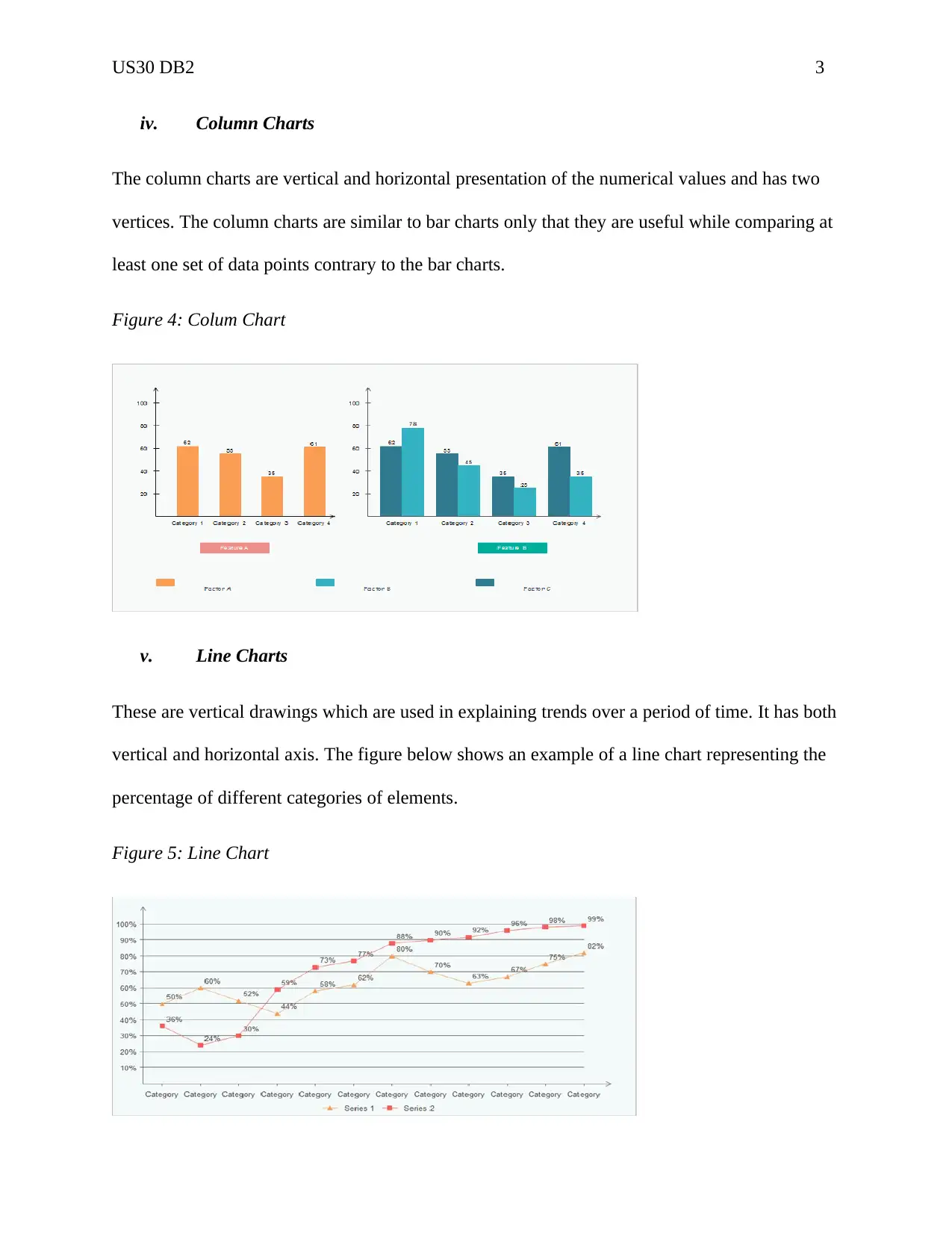
US30 DB2 3
iv. Column Charts
The column charts are vertical and horizontal presentation of the numerical values and has two
vertices. The column charts are similar to bar charts only that they are useful while comparing at
least one set of data points contrary to the bar charts.
Figure 4: Colum Chart
v. Line Charts
These are vertical drawings which are used in explaining trends over a period of time. It has both
vertical and horizontal axis. The figure below shows an example of a line chart representing the
percentage of different categories of elements.
Figure 5: Line Chart
iv. Column Charts
The column charts are vertical and horizontal presentation of the numerical values and has two
vertices. The column charts are similar to bar charts only that they are useful while comparing at
least one set of data points contrary to the bar charts.
Figure 4: Colum Chart
v. Line Charts
These are vertical drawings which are used in explaining trends over a period of time. It has both
vertical and horizontal axis. The figure below shows an example of a line chart representing the
percentage of different categories of elements.
Figure 5: Line Chart
⊘ This is a preview!⊘
Do you want full access?
Subscribe today to unlock all pages.

Trusted by 1+ million students worldwide
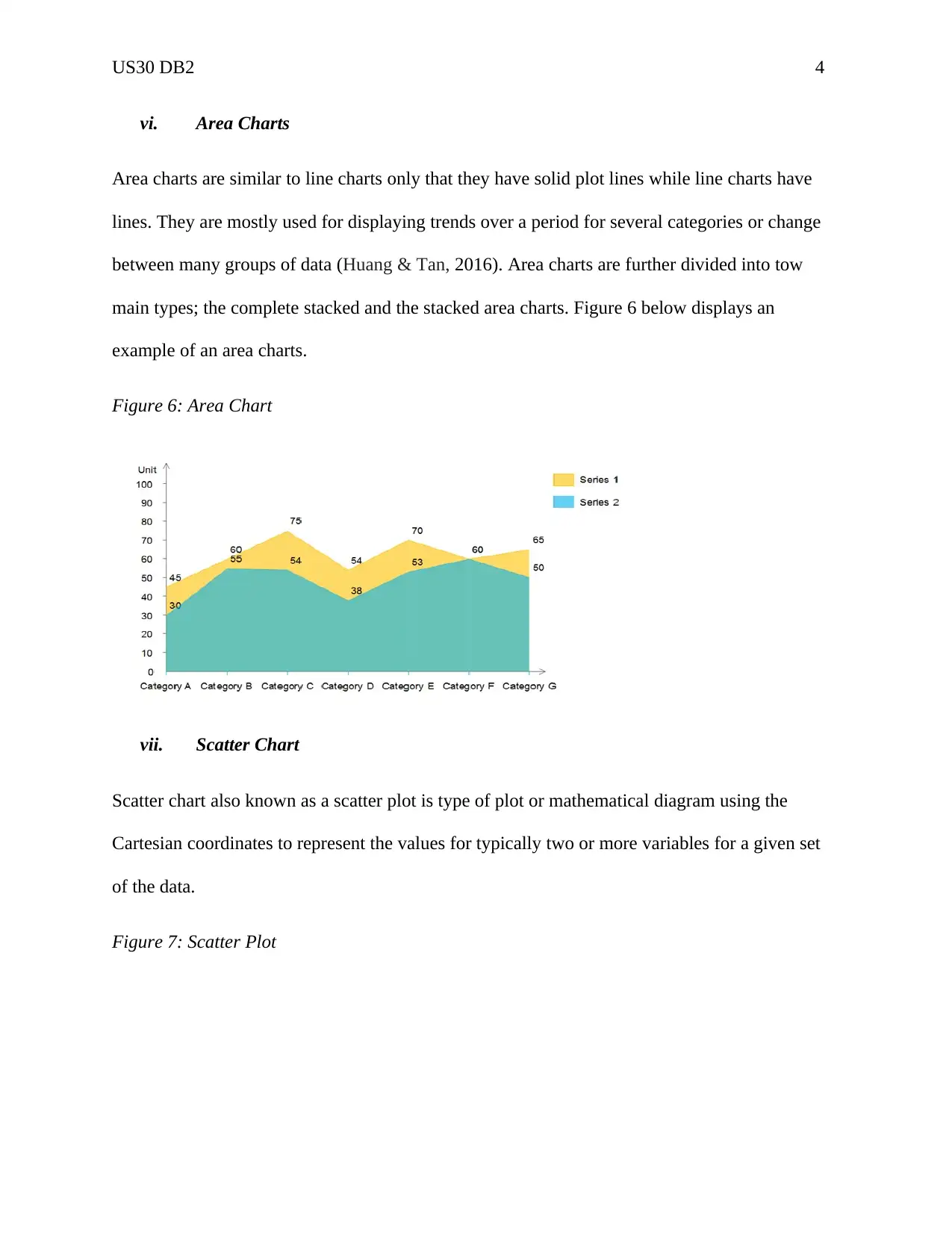
US30 DB2 4
vi. Area Charts
Area charts are similar to line charts only that they have solid plot lines while line charts have
lines. They are mostly used for displaying trends over a period for several categories or change
between many groups of data (Huang & Tan, 2016). Area charts are further divided into tow
main types; the complete stacked and the stacked area charts. Figure 6 below displays an
example of an area charts.
Figure 6: Area Chart
vii. Scatter Chart
Scatter chart also known as a scatter plot is type of plot or mathematical diagram using the
Cartesian coordinates to represent the values for typically two or more variables for a given set
of the data.
Figure 7: Scatter Plot
vi. Area Charts
Area charts are similar to line charts only that they have solid plot lines while line charts have
lines. They are mostly used for displaying trends over a period for several categories or change
between many groups of data (Huang & Tan, 2016). Area charts are further divided into tow
main types; the complete stacked and the stacked area charts. Figure 6 below displays an
example of an area charts.
Figure 6: Area Chart
vii. Scatter Chart
Scatter chart also known as a scatter plot is type of plot or mathematical diagram using the
Cartesian coordinates to represent the values for typically two or more variables for a given set
of the data.
Figure 7: Scatter Plot
Paraphrase This Document
Need a fresh take? Get an instant paraphrase of this document with our AI Paraphraser
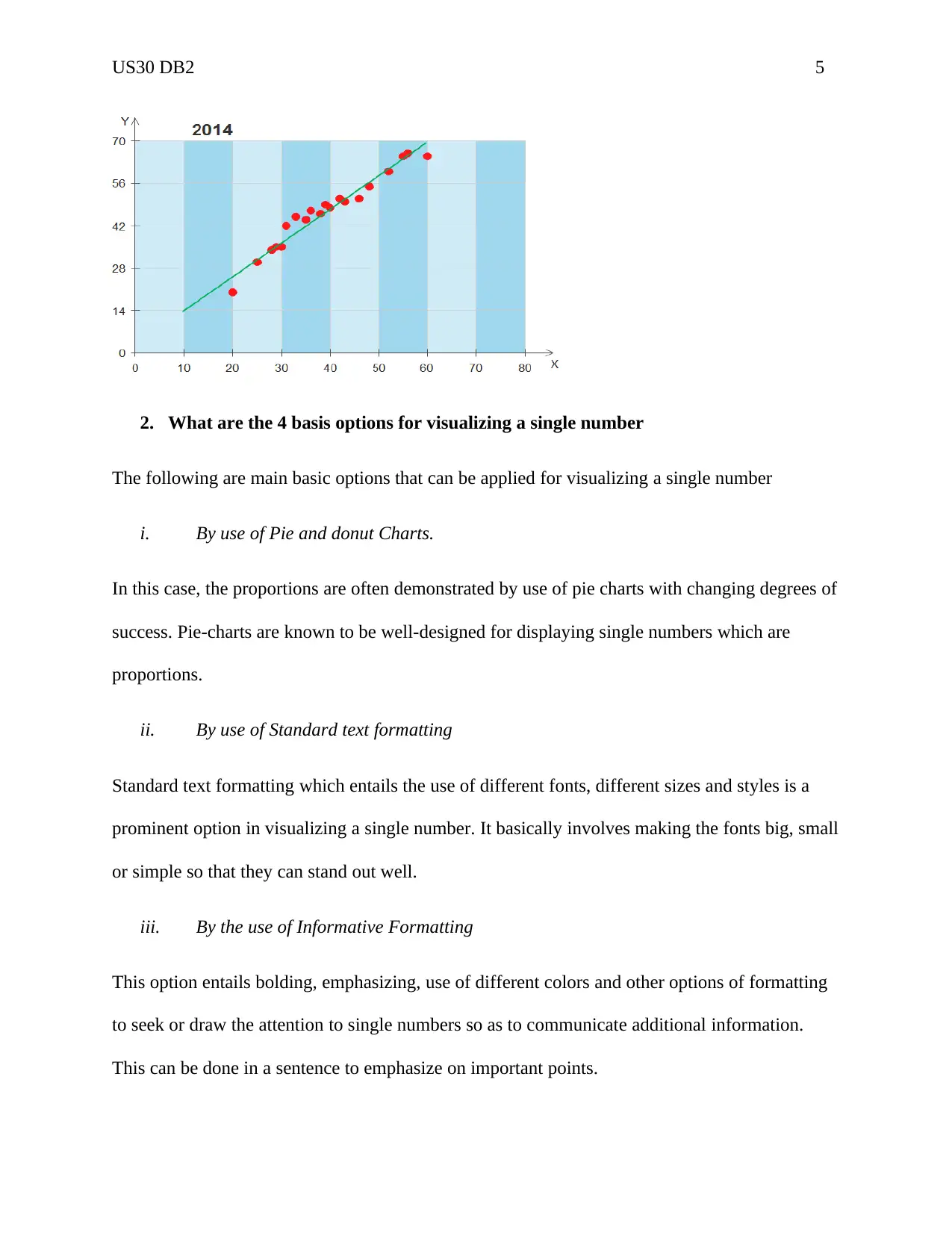
US30 DB2 5
2. What are the 4 basis options for visualizing a single number
The following are main basic options that can be applied for visualizing a single number
i. By use of Pie and donut Charts.
In this case, the proportions are often demonstrated by use of pie charts with changing degrees of
success. Pie-charts are known to be well-designed for displaying single numbers which are
proportions.
ii. By use of Standard text formatting
Standard text formatting which entails the use of different fonts, different sizes and styles is a
prominent option in visualizing a single number. It basically involves making the fonts big, small
or simple so that they can stand out well.
iii. By the use of Informative Formatting
This option entails bolding, emphasizing, use of different colors and other options of formatting
to seek or draw the attention to single numbers so as to communicate additional information.
This can be done in a sentence to emphasize on important points.
2. What are the 4 basis options for visualizing a single number
The following are main basic options that can be applied for visualizing a single number
i. By use of Pie and donut Charts.
In this case, the proportions are often demonstrated by use of pie charts with changing degrees of
success. Pie-charts are known to be well-designed for displaying single numbers which are
proportions.
ii. By use of Standard text formatting
Standard text formatting which entails the use of different fonts, different sizes and styles is a
prominent option in visualizing a single number. It basically involves making the fonts big, small
or simple so that they can stand out well.
iii. By the use of Informative Formatting
This option entails bolding, emphasizing, use of different colors and other options of formatting
to seek or draw the attention to single numbers so as to communicate additional information.
This can be done in a sentence to emphasize on important points.
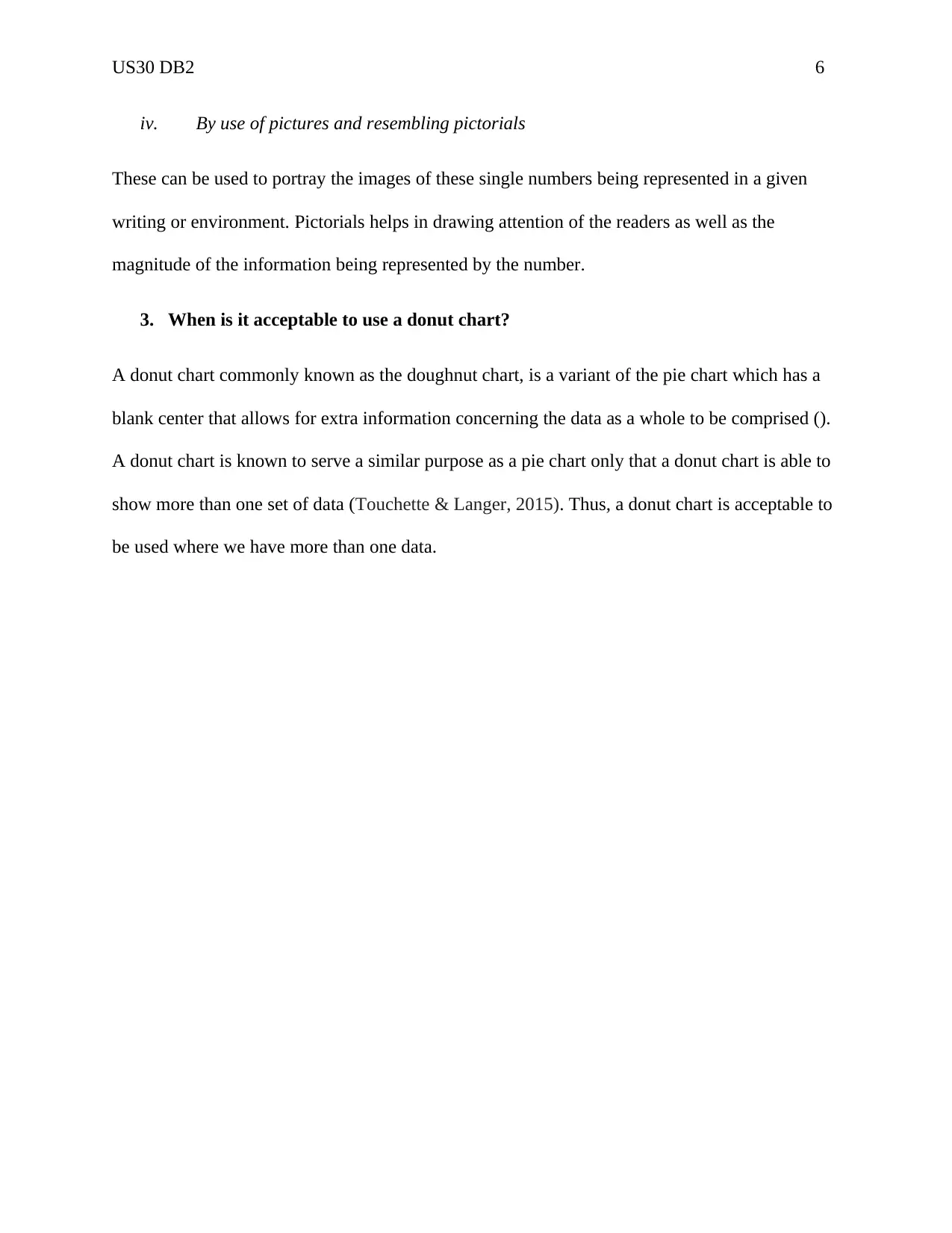
US30 DB2 6
iv. By use of pictures and resembling pictorials
These can be used to portray the images of these single numbers being represented in a given
writing or environment. Pictorials helps in drawing attention of the readers as well as the
magnitude of the information being represented by the number.
3. When is it acceptable to use a donut chart?
A donut chart commonly known as the doughnut chart, is a variant of the pie chart which has a
blank center that allows for extra information concerning the data as a whole to be comprised ().
A donut chart is known to serve a similar purpose as a pie chart only that a donut chart is able to
show more than one set of data (Touchette & Langer, 2015). Thus, a donut chart is acceptable to
be used where we have more than one data.
iv. By use of pictures and resembling pictorials
These can be used to portray the images of these single numbers being represented in a given
writing or environment. Pictorials helps in drawing attention of the readers as well as the
magnitude of the information being represented by the number.
3. When is it acceptable to use a donut chart?
A donut chart commonly known as the doughnut chart, is a variant of the pie chart which has a
blank center that allows for extra information concerning the data as a whole to be comprised ().
A donut chart is known to serve a similar purpose as a pie chart only that a donut chart is able to
show more than one set of data (Touchette & Langer, 2015). Thus, a donut chart is acceptable to
be used where we have more than one data.
⊘ This is a preview!⊘
Do you want full access?
Subscribe today to unlock all pages.

Trusted by 1+ million students worldwide
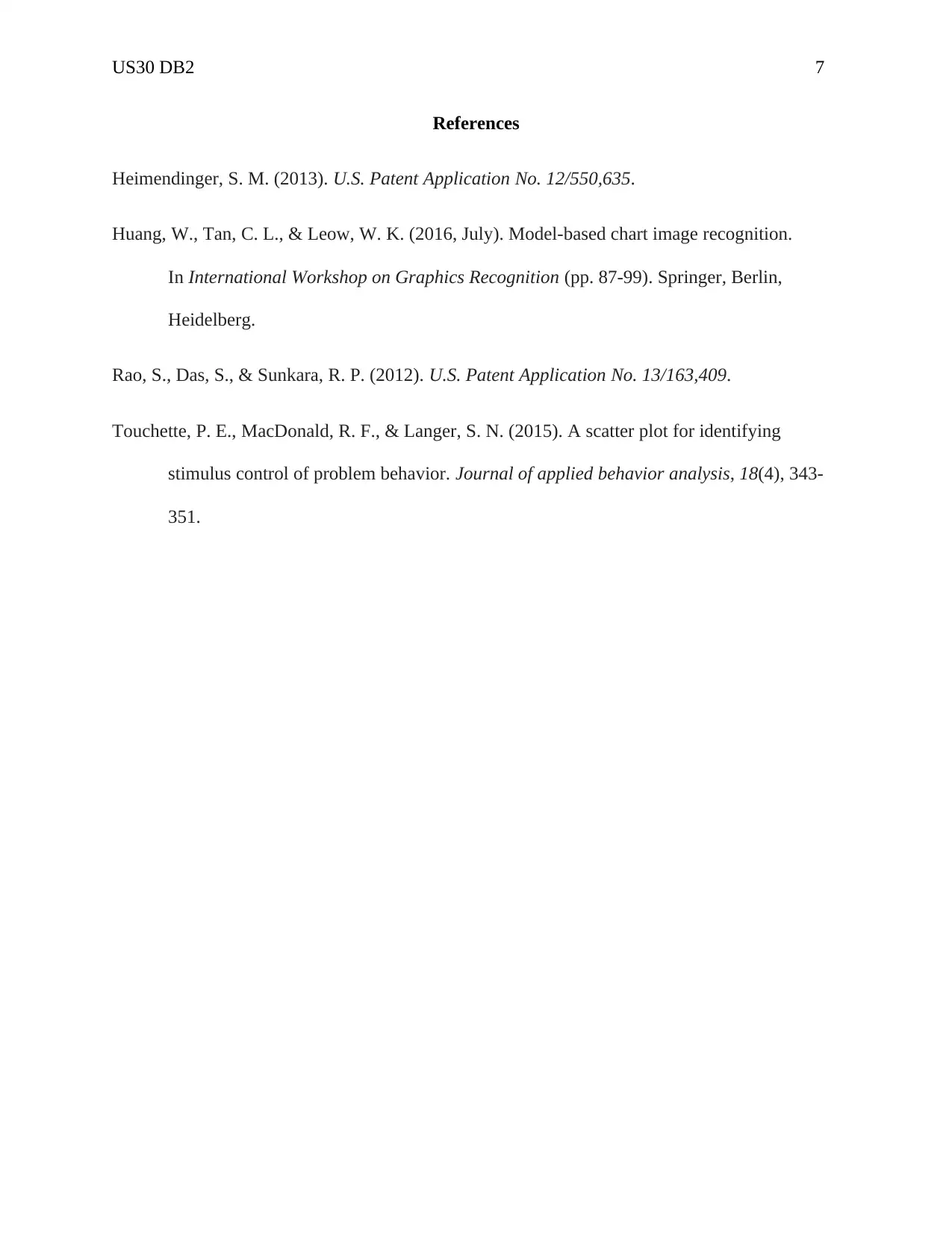
US30 DB2 7
References
Heimendinger, S. M. (2013). U.S. Patent Application No. 12/550,635.
Huang, W., Tan, C. L., & Leow, W. K. (2016, July). Model-based chart image recognition.
In International Workshop on Graphics Recognition (pp. 87-99). Springer, Berlin,
Heidelberg.
Rao, S., Das, S., & Sunkara, R. P. (2012). U.S. Patent Application No. 13/163,409.
Touchette, P. E., MacDonald, R. F., & Langer, S. N. (2015). A scatter plot for identifying
stimulus control of problem behavior. Journal of applied behavior analysis, 18(4), 343-
351.
References
Heimendinger, S. M. (2013). U.S. Patent Application No. 12/550,635.
Huang, W., Tan, C. L., & Leow, W. K. (2016, July). Model-based chart image recognition.
In International Workshop on Graphics Recognition (pp. 87-99). Springer, Berlin,
Heidelberg.
Rao, S., Das, S., & Sunkara, R. P. (2012). U.S. Patent Application No. 13/163,409.
Touchette, P. E., MacDonald, R. F., & Langer, S. N. (2015). A scatter plot for identifying
stimulus control of problem behavior. Journal of applied behavior analysis, 18(4), 343-
351.
1 out of 7
Related Documents
Your All-in-One AI-Powered Toolkit for Academic Success.
+13062052269
info@desklib.com
Available 24*7 on WhatsApp / Email
![[object Object]](/_next/static/media/star-bottom.7253800d.svg)
Unlock your academic potential
Copyright © 2020–2025 A2Z Services. All Rights Reserved. Developed and managed by ZUCOL.





